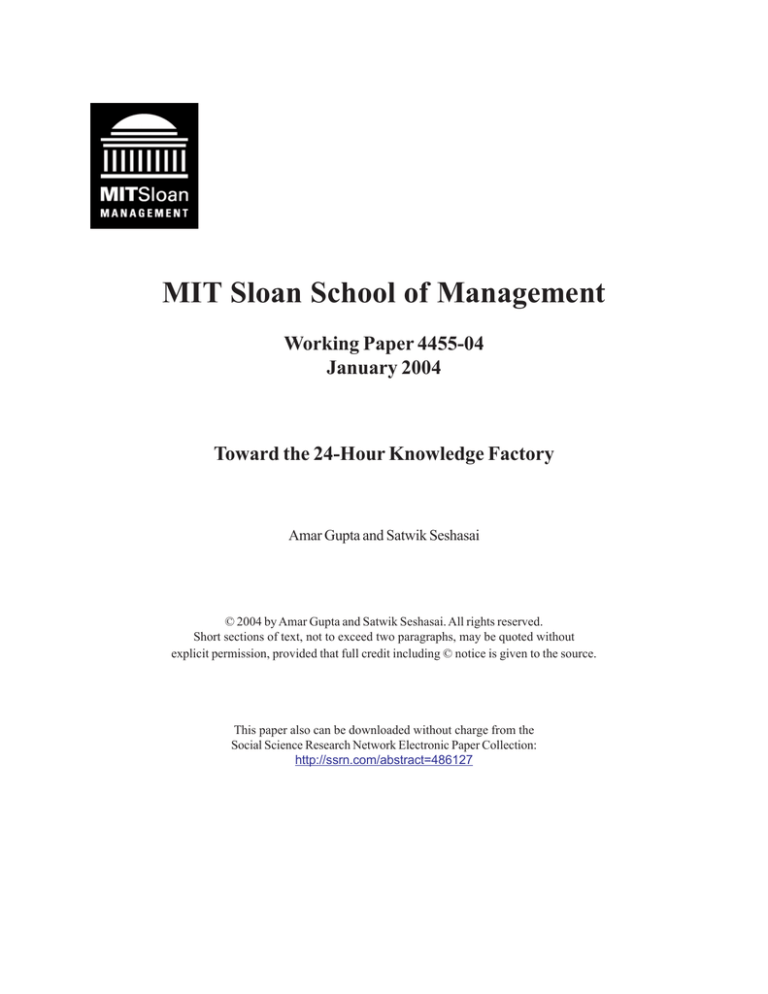
MIT Sloan School of Management
Working Paper 4455-04
January 2004
Toward the 24-Hour Knowledge Factory
Amar Gupta and Satwik Seshasai
© 2004 by Amar Gupta and Satwik Seshasai. All rights reserved.
Short sections of text, not to exceed two paragraphs, may be quoted without
explicit permission, provided that full credit including © notice is given to the source.
This paper also can be downloaded without charge from the
Social Science Research Network Electronic Paper Collection:
http://ssrn.com/abstract=486127
Toward the 24-Hour Knowledge Factory
Amar Gupta and Satwik Seshasai
Massachusetts Institute of Technology
1 Broadway
Cambridge, MA, 02139 U.S.A.
Email: agupta@mit.edu and satwik@mit.edu
The term “24-Hour Knowledge Factory” connotes a globally
distributed work environment in which members of the global
team work on a project around the clock; each member of the
team works the normal workday hours that pertain to his or her
time zone. At the end of such a workday, a fellow team member
located in a different time zone continues the same task. This
creates the shift-style workforce that was originally conceived
in the manufacturing sector. A globally distributed 24-hour call
center is the simplest manifestation of this paradigm. The true
example of the 24-hour factory paradigm discussed in this
paper involves groups working together to accomplish a given
set of deliverables, such as a software project, and transcending
conventional spatial and temporal boundaries.
INTRODUCTION
“The Sun never sets on the British Empire,” was a notion emphasized
during the eighteenth and nineteenth centuries to highlight that the British
Empire was far-flung, and that the sun was always visible from some part of
this vast empire. While the British Empire has gradually disintegrated, we
can now coin an equivalent notion: “The Sun never sets on the 24-hour
Knowledge Factory!”
The notion of the 24-hour Knowledge Factory can be traced back to
the industrial revolution. Since the installed equipment was scarce and
costly, the employees were scheduled to work in shifts of 8 hours in order to
use the manufacturing facilities on a round-the-clock basis. With the advent
of electronic computers and diminishing costs for telecommunications, one
developed the notion of 24-hour Call Centers. Depending on the time of the
call, it is automatically directed to a call center that is active at that time.
Using a cluster of 3 to 4 call centers located in time zones 6-8 hours apart
from the time zone of the neighboring call center, one can ensure that all
employees of these geographically distributed call centers are working
Toward the 24-Hour Knowledge Factory
during daytime in their respective countries. The notion of multiple support
centers was subsequently adapted for supporting global communications
networks over time. Now it has become feasible for one to use a
geographically distributed workforce of highly trained professionals to
complete a challenging endeavor in a much shorter timeframe as compared
to a scenario in which all personnel are based at one location, irrespective of
where location is.
For example, by involving specialized microchip design engineers
located at multiple places around the world, a semiconductor chip design
firm may create virtual “24-hour knowledge factories”. This allows for an
efficient design process that has a faster turnaround time. It provides the
firm with access to high-talent designers who would otherwise have to move
to a different country, or work at odd hours of the night; some persons call
the latter type of shift as the “graveyard shift”. The figure below illustrates a
distributed factory with software design operations in three countries around
the world. The creation of professional service teams that transcend
geographic and temporal boundaries offers the potential to change the face
of many industries. This new innovation will dramatically impact the
manner in which companies build, test, sell and support their products and
services. Years ago, people in India and the United States thought the time
difference was a negative - they thought it would hinder their ability to work
with US firms. Now that's switched around - for many projects the time
difference is a plus, as it enables the creation of the 24-hour Knowledge
Factories described in this paper.
The 24-hour Knowledge Factory will involve “offshoring” of part of
the endeavor. Today, offshoring is done mainly to reduce costs. We believe
that over time, the growth in offshoring will be fueled more by the potential
to achieve drastic reductions in turnaround times for major endeavors.
Page 2 of 11
Toward the 24-Hour Knowledge Factory
Figure 1: In this sample 24-hour global knowledge factory, a software team increases
efficiency by having designing, coding and testing done at different times of the day, so
that work that would have been performed over three days may now be done within a 24
hour cycle
FOUNDATIONS OF 24-HOUR KNOWLEDGE FACTORY
Emerging communications and infrastructure technologies can be
applied to bridge teams across geographic and temporal boundaries,
especially to accomplish rapid development of next generation products with
work on a 24-hour/day basis. In order to do this effectively, one needs to
develop new paradigms to facilitate interpersonal communications and
collaboration. For example, there is a growing need for robust knowledge
transfer mechanisms that can facilitate knowledge management on a daily
basis, and simultaneously enable the creation of a growing knowledge
repository over time.
A survey of over 50 software executives participating in offshoring
highlighted that “offshoring will live or die based on the ability of everyone
involved to communicate with each other.”1
Richer collaboration
technologies need to become available in order to enable simultaneous use
of video, audio and other messaging capabilities to link geographically and
temporally separated teams. Such efforts would require deep understanding
of evolving technology and business needs.
Page 3 of 11
Toward the 24-Hour Knowledge Factory
In the initial instance, the new technologies may be usable for very
specific disciplines or applications only. For example, after the collapse of
the walkway at a leading hotel in Chicago that resulted in multiple deaths
and was ultimately traced to poor communications between the various
groups involved in designing and building that walkway, researchers at MIT
looked at ways for mitigating such interpersonal and interdisciplinary
communication problems. In the case of this hotel disaster, the design for
the walkway had passed from the structural engineer, to the architect, to the
construction engineers, and finally to the on-site construction crew, with
significant changes being made at each point without proper communication
between the concerned sets of personnel. As part of the multiyear research
endeavor at MIT, one concluded that there was a high degree of domain
knowledge that was needed to resolve the underlying problem of effective
communication among the concerned parties.
Some parts of the research conducted at MIT, primarily in the
Department of Civil and Environmental Engineering, could be readily
leveraged for use in other environments; others parts could not. The DRIM
and DICE projects grew out of this effort; the techniques developed as part
of these projects can be potentially leveraged to help accomplish the full
vision for 24-hour knowledge factories. DRIM is a completely specified
model for the rationale underlying the design process2. The use of such a
model in a 24-hour knowledge factory would allow for tasks to be shared
between geographies and time zones without requiring the engineers to
spend a significant amount of time explaining their work to persons in the
next ”shift”.
The DICE (Distributed and Integrated Collaborative
Engineering Environment) methodology offers a platform for collaborative
engineering by decomposing each project into a set of modules and allowing
work to be conducted in parallel on each section of the project3. When the
system encounters conflicting decisions about a particular decision from
engineers in different modules, it uses the design rationale to help negotiate
the outcome. In a 24-hour knowledge factory, where high efficiency is a
primary goal, one needs to apply advanced versions of such techniques to
integrate the work of many persons working at different times and in
different geographic locations.
In a "24-hour development environment" that encompasses three or
more development centers located around the world, the distributed team is
envisaged to concentrate on the same problem and to perform the same
function (whether it be development of code or testing of subsystem) on a
successive basis, with each collaborating center retaining ownership of the
endeavor for 8-hour periods in every 24-hour cycle. Many industries,
Page 4 of 11
Toward the 24-Hour Knowledge Factory
including the software industry, are characterized by a development cycle
that relies heavily on sequential performance of specific functions, such as
development, testing, and verification. In a traditional software development
environment where all parties are located in the same geographic area, a
code developer typically waits until a fully functional portion of the product
is available before passing it on to an engineer to test it. However with the
potential for receiving testing feedback overnight, the developer now has the
unprecedented opportunity to build portions of the product on an
incremental and more daily basis.
Engineers and other professionals often innovate through personal and
group contact, sharing ideas and building on each other’s suggestions. These
interactions can occur via formal meetings in conference rooms or informal
ones in the corridor. While technologies exist to achieve some of this
functionality with both synchronous and asynchronous communication
capabilities, there still exists a critical need to replicate the culture of freeflowing exchange of ideas without the impediments created by
communication tools. One option for supporting interpersonal relationships
between the team members is to have them meet in person at various times
throughout the duration of the project. The use of any such method will still
have to work with the requirement that team members will remain
geographically separated for the majority of the time.
Another related issue is the dispersion of knowledge centers regarding
teams, projects and technologies. With global teams being created, the
opportunity to informally interact with a colleague in the same geography
will not exist as much. Dilemmas that are normally solved with casual
lunchtime conversation, or hallway meetings, will need to be dealt with
using communication technologies such as instant messaging, video and
audio conferencing and electronic mail.
One of the greatest challenges is how to collect and disseminate
information about which professionals have knowledge about which topics.
This challenge needs to be addressed in a manner that does not impede the
productivity of the concerned professionals. As the relevant technologies
continue to evolve, the nature of communication between professionals on a
team will also continue to evolve. Thus, the technological approach to
facilitating outsourcing has to constantly re-evaluate the nature of
communication within global teams and adapt accordingly.
In order to create an integrated archipelago of knowledge-based
assets, one needs to look at new paradigms that can help to effectively
transcend national borders, corporate borders, cultural borders, functional
borders, and other types of borders, and provide the material needed to
Page 5 of 11
Toward the 24-Hour Knowledge Factory
address the individual needs of an increasingly diverse set of users of such
systems. By providing effective "on-off ramps" to the emerging information
highways, the goal is to drastically enhance drastically the ability to make
effective use of large volumes of information obtained from disparate
sources (each with its own set of underlying meanings and assumptions), by
transforming automatically the incoming streams of information to the
desired meaning (or context) needed for a particular job or function in a
particular nation or organization.
Continued exploration of the technology issues would ultimately lead
to a new optimal balance in the service arena, this could be similar to the
balance attained in the manufacturing arena. In the end-scenario, workers in
the U.S. may concentrate on design and development of high level products
and features, rather than on low-paying tasks such as software maintenance
that require less education and training.
SAMPLE TECHNOLOGIES FOR SURMOUNTING BOUNDARIES
Two sample technologies were developed by the authors to
demonstrate potentially useful methods in building the 24-hour knowledge
factory. Both were tested in a real-world situation involving the design of
satellites.
The Multi-Attribute Tradespace Exploration (MATE) system focuses
on the issue of capturing and processing the goals and the requirements of
decentralized stakeholders in the design process. It provides a formalized
means of exploring a tradespace by incorporating preferences into decision
criteria with methods based in economic and operations research theory*.
Both utility analysis methods and cost-benefit analysis methods are
employed to obtain information from all of the stakeholders in the
geographically and organizationally decentralized design process and to
facilitate communication between them. The principle means of eliciting
information is by conducting a series of interviews with the stakeholders
designed to help capture their preferences regarding the various attributes of
the design architecture. These data are then used to drive the design process,
by providing information about the utility and cost of each potential
architectural alternative. In the 24-hour knowledge factory, such a system
would allow for the opinions of the decision-makers’ to be represented even
when they are not available at the same time or place. The overall approach
provides a formal, mathematical framework for incorporating the views of
all stakeholders in a systematic manner, even when some of these
stakeholders may be on the other side of the world.
Page 6 of 11
Toward the 24-Hour Knowledge Factory
The SSPARCy system is geared to capture, reuse and better exploit
valuable information assets, with the objective of mitigating temporal and
spatial barriers in large multi-organizational multidisciplinary endeavors. In
a number of applications ranging from marketing campaigns of new
products to the design of new systems, each campaign or design process is
frequently conducted as a new endeavor. Very little knowledge, if any, is
carried over from the previous episode or campaign. In order to provide
better inspection and analysis of the future simulation files, a new approach
was developed to provide automated capture and storage of important
information (name, value, rationale, author, etc) relating to each component
of the project, along with the history of these data. While most of this
functionality is automated, the user is prompted to document the rationale
when significant changes are made to the design or the implementation. This
concept demonstration system can facilitate the 24-hour knowledge factory
by allowing projects to be transferred easily between teams, without
requiring each team to invest time in transferring the knowledge of previous
projects. It also allows teams to look at decisions made on earlier projects
that involved decisions on similar issues.
ECONOMIC & POLICY CHALLENGES
The potential distribution of teams across geographic and temporal
boundaries requires careful consideration of the economic ramifications of
alternative distribution models in order to elicit the optimal benefits from the
globally distributed model. While some lessons can be learned from the
experiences of globalization in manufacturing industries, the inherent
distributed nature of the 24-hour global knowledge factory presents many
new challenges. The significant costs for collaboration, as well as for
replicated hardware and software, may gradually rise with increasing use of
outsourcing concepts. One may consider the possibility of using the same
hardware across borders for testing and other purposes. Further, there are
costs involved in establishing effective hiring processes, and in travel
between onshore and offshore locations5* – both of these factors impose
financial overheads whose benefits may be hard to quantify.
Another major change is the widening of the competitive landscape.
The lowering of costs in the software industry is making it possible for
smaller firms to compete much more readily with larger firms, because they
have access to a greater labor pool much more easily*5. With many
professional services, the startup costs are lower, and do not involve the
significant capital investments that characterize the manufacturing scenario.
These facts allow smaller competitors to enter new markets and to maintain
Page 7 of 11
Toward the 24-Hour Knowledge Factory
a small core of designers onshore with a large pool of offshore professional
service workers to carry out the tasks.
Changes in government policies will impact this field too. On one
side, evolving labor and trade regulations may limit the amount of offshore
work that can be performed abroad. On the other, the tightening of the Visa
regulations to control the number of foreign workers into the U.S. will
actually serve as a catalyst to the growth of the 24-hour Knowledge Factory.
Further, data security, privacy standards, and export regulations on
encryption technology are issues on which developing nations do not have
the same standards that the United States does. This disparity serves as an
impediment to the execution of the same task across nations in a 24-hour
knowledge factory.
The 24-hour knowledge factory model can also influence the strategic
direction to be taken by developed nations in attempting to maintain jobs for
professional service workers who might otherwise be losing their jobs to
offshore labor markets.
In testimony before the U.S. House of
Representatives Committee on Small Business, Assistant Secretary for
Technology Policy Bruce Mehlman has cited the United States policy
strategy to be based on an investment in education, infrastructure,
innovation, and to highlight existing benefits such as intellectual property
protection4. Such a strategy, in the context of a 24-hour knowledge factory
model, suggests that the most sustainable model will be to prepare U.S.
professional service workers to perform higher level tasks and allow tasks
which require less education, training and infrastructure to be performed
abroad. Rather than use these strategies to build a legislative wall around
the United States, if the 24-hour knowledge factory model is adopted, tasks
will be performed much more efficiently because the U.S. engineers will be
equipped to handle the more specialized parts of the shared onshore-offshore
projects. These strategies are necessary for the United States to remain
competitive, but they must also take into account the fact that outsourcing
may change the way firms perceive their interests. For example, a recent
report1 reveals that software executives do not prioritize intellectual property
protection as highly as anticipated when making decisions related to
outsourcing.
The following table summarizes the benefits of onshore and offshore
engagements, as reported by the U.S. Department of Commerce Office of
Technology Policy after convening business, university and government
leaders5:
Page 8 of 11
Toward the 24-Hour Knowledge Factory
People
Business Climate
Infrastructure
Market Access
Intellectual Property
Government
Quality of Life
Onshore Benefits
Talent
pool
is
unmatched
Entrepreneurial,
market-based,
easy
access to capital
Telecom,
energy,
transport
Innovation in largest
market
Commitment to patents
Political stability
Freedom, health care,
security, environment
Offshore Benefits
Untapped talent pool
Less
burdensome
taxation,
regulation,
litigation
New global clusters
created
Untapped markets
Talent, facilities cost
less
Plants
are
already
offshore
Cost
Proximity to
manufacturing
The win-win potential of the 24-hour knowledge factory can be
established by taking the best from both onshore and offshore markets and
combining them into one model with concurrent engagement on professional
services tasks. For example, the untapped foreign talent pool can be
engaged without requiring major financial, organizational and educational
infrastructure investment. Both the total development time and costs can be
substantially reduced. Accordingly, pertinent government agencies are likely
to favor policies that facilitate a 24-hour knowledge factory model, rather
than a completely onshore model (which will most likely lead to a
segregated offshore model).
In understanding the strategic direction to be taken in terms of
educating and re-educating the professional services workforce of the United
States to better compete or co-exist with offshore professional service labor,
it is important to understand the complex requirements of the job market.
The U.S. Secretary of Commerce’s report entitled “Education and Training
for the Information Technology Workforce” states that IT employers are
looking for a specific blend of technical and business skills, and prioritize a
minimal amount of training5. This notion of flexible training that will allow
workers to succeed in a changing marketplace for professional services is
useful in determining the strategic direction for both onshore and offshore
Page 9 of 11
Toward the 24-Hour Knowledge Factory
firms. The burden will increase on practicing engineers and other
professional service workers to take on more organizational and cultural
leadership, both to interact with foreign counterparts and to take on higherlevel tasks. The policy for dealing with offshore outsourcing should be to
acknowledge this fact, and should nucleate the training needed to enable
U.S. engineers to work in 24-hour knowledge factories, instead of in highly
guarded, isolated onshore teams.
Finally, the inherent nature of strategic and political relations requires
that a firm incorporate the risk of unexpectedly severing relations with
foreign professionals who possess much of their intellectual and institutional
knowledge. If firms are actively engaged in 24-hour knowledge factories,
some of this diversification is built into the model. Losing an offshore team
will not mean losing an entire project, as may happen if entire tasks are
outsourced. The overriding importance of maintaining a knowledge base as
diverse and redundant as possible promotes the 24-hour knowledge factory
model.
CONCLUSION
Professional services have the opportunity to move towards the “24hour global knowledge factory” where active progress on professionally
intensive tasks is accomplished on a round-the-clock basis. This future will
be realized through careful consideration of the needs and expectations of
the concerned stakeholders at the strategic, technical, economic and
organizational dimensions. Once firms, governments, and individual
workers adopt a unified approach, all constituencies will benefit through the
use of the 24-hour knowledge factory concept. As the relevant issues are
addressed, outsourcing of appropriate components of knowledge jobs to
less-expensive labor markets will be increasingly perceived as an
opportunity for U.S. businesses to offer new products sooner to the global
market, and with better returns both to customers and shareholders.
REFERENCES
1
“The Roadmap to Offshore Success”. The Sand Hill Group, 2003.
Pena-Mora, F., Sriram, R., and Logcher, R. “Conflict Mitigation System for
Collaborative Engineering.” Artificial Intelligence in Engineering Design, Analysis and
Manufacturing. pp. 101-124, 1995.
3
Sriram, Ram D. Distributed and Integrated Collaborative Engineering Environment.
4
Mehlman, Bruce C. Testimony before the U.S. House of Representatives Committee on
Small Business. United States Department of Commerce, June 18, 2003.
2
Page 10 of 11
Toward the 24-Hour Knowledge Factory
5
Meares, Carol A. and John F. Sargent. “Education and Training for the Information
Technology Workforce.” Report to Congress from the Secretary of Commerce, June
2003.
Page 11 of 11






